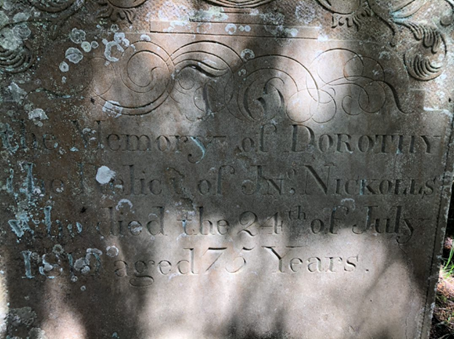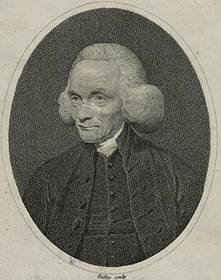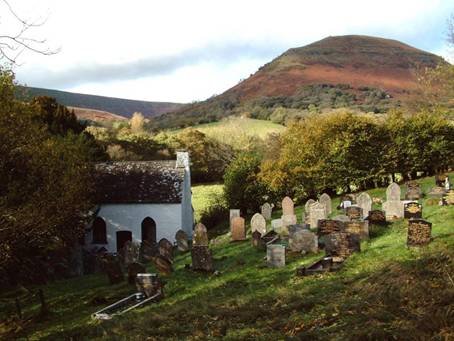Held at: | Private Collection |
Reference: | MG |
Source: | Guest Contribution |
Title: | Guest Contribution: Walking over the mountain - the Baptist community of Olchon and Capel-y-ffin |
Place name: | Llanveynoe, Olchon |
Date: | 1719 - 1886 |
Description:
This paper is written by Miriam Griffiths and is reproduced here with the author’s kind permission. The author is in the process of researching the history of and myths about the Olchon Baptist Church community in the 17th , 18th and 19th centuries; this is a short piece from work in progress. It was first published by the Llanthony Valley and District History Group in 2021.
Ewyas Lacy Study Group.
Walking over the mountain - the Baptist community of Olchon and Capel-y-ffin.
By Miriam Griffiths
Dorothy’s story
In October 1801 Dorothy Nicholls, a widow aged 48 who lived in the Olchon valley, was baptised in the River Honddu just below Capel-y-ffin Baptist chapel. Believer’s (adult rather than infant) baptism was a key tenet of the Baptist community that had straddled the mountain between the Llanthony and Olchon valleys for about 150 years before 1801. After her immersion she no doubt hurried up into the Chapel - perhaps a fire was lit in the Chapel’s fireplace - to get warm and dry; in the 1990s local historian Isabel McGraghan noted people’s recollections of this still happening into the 20th century. Afterwards, Dorothy would have walked back home over the mountain that separates the Olchon and Llanthony valleys to her home (now our house), Olchon Court farm in the Olchon valley.
Whilst Dorothy’s earlier rites of passage (eg her children’s baptisms) were recorded in established Church registers in Radnorshire where she had lived previously it seems, perhaps after moving to the Olchon, she decided to join the Baptist church. This term Baptist ‘church’ refers to the community of believers rather than a specific building. Dorothy was buried in 1819 at Capel-y-ffin Baptist Chapel; was her coffin carried over the mountain? Between her baptism and her burial her name appears a few times in surviving Chapel records.
| Dorothy Nicholls’ grave at Capel y ffin Baptist Chapel |
|
|
The border between Wales and England ran and still runs along the Hatterrall ridge which separates the two valleys. Stories of people walking over the steep-sided mountain for prayer meetings are well-established in local tradition. Looking for specific evidence of Olchon residents’ names in the Chapel record, I have found just a few, including Llanveynoe resident James Price who was threatened with exclusion for non-attendance in 1801; and nearly 100 years later, Ann Price of The Castle farm (near Olchon’s Black Darren, now a ruin) was buried at Capel -y-ffin in 1896. But they, like Dorothy, are 19th century people and the story of the Olchon/Capel-y-ffin Baptists goes much further back to an era when records and evidence are harder to find.
Joshua Thomas
The key source of information about the earliest Baptist history in the Olchon/Capel-y-ffin area is Joshua Thomas (1719-1797), a Baptist Minister and historian who wrote in both English and Welsh. In his accounts, which cover the history up to the 1790s, Thomas uses the terms the ‘Olchon church’ or just ‘Olchon’ as an umbrella name. Up till the building of the Capel-y-ffin Chapel in the mid-17th century there had been no purpose-built meeting house in either valley, and the community met in people’s homes, farm buildings or out of doors; the Chapel at Capel-y-ffin created a new focus for meetings and administration. Thomas observed (writing in 1790) that following the building of the Capel-y-ffin Chapel “…the old name Olchon, is now almost lost in this name of the Meeting house” . This helps us unravel some of the confusions that have arisen about the early history because some later writers using Thomas as their information source have sometimes assumed that everything Thomas mentioned happened in the Olchon valley. A booklet published in Abergavenny in 1919, which was directly derived from Thomas’s writings, tried to clarify this in its title, ‘The History of the Olchon Church otherwise known as Capel-y-ffin’.
| Joshua Thomas
|
|
|
While he was Baptist Minister at Hay on Wye between 1745 and 1754, Thomas preached in Welsh twice a month at Olchon (he says Welsh was the language of residents on the English side of the border at the time) and he gathered information about the history by collecting older peoples’ memories and knowledge passed down to them from earlier generations. He concluded that this was one of the very earliest Baptist churches in Wales, originating in the late 1630s, and that the Olchon river had a special place in the early history of adult Believer’s Baptism; the brook’s name may derive from the Welsh word golchi, to dip or wash, which has connotations of sheep dipping and also perhaps immersive baptism. Joshua Thomas’s oral history research methods (as we would call them now) provide credible glimpses of local history. He also acknowledged many gaps in his account which he did fill with a bit of admitted guesswork.
Some aspects of Thomas’ writing were highly speculative and romanticised; he strayed deep into supposition when he wrote about individuals whom he saw as early forerunners of religious dissent in the area; one example is Sir John Oldcastle who as a Lollard was hunted down as a traitor and religious law-breaker in the early 1400s. Thomas makes several erroneous assumptions about Oldcastle for which there is no evidence and convinces himself that Oldcastle hid out from his pursuers in the Olchon. (And the Oldcastle family name came from the family seat in the Almeley area of Herefordshire, not from the Oldcastle hamlet in Monmouthshire, just down the road from the Olchon Valley.) Thomas was keen to establish a long tradition of Baptist beliefs pre-dating the actual emergence of those who identified as Baptists and reading his accounts one can see some emotional investment in imagining Olchon’s role in the tracing of a deep-rooted Baptist past right back to St John. These speculative aspects and unproven suggestions have found their way into many subsequent accounts of the early Olchon/Capel-y-ffin Baptists, leading to some mythologising and unfounded claims of historical fact. On the plus side this story gave us Raymond Williams’ chapter in his book The People of the Black Mountains entitled ‘Oldcastle in Olchon’.
‘The Persecuting Time’
For about 30 years between 1660 (restoration of King Charles II) and 1689 (Act of Toleration) religious practice outside the established Church was illegal and religious dissenters met secretly, risking severe punishments:
In the persecuting time they met to worship where they could, sometimes a friend’s house secretly, and often out [of doors]. One day or night they would agree to assemble in one retired place on the Black Mountain, then in another. When they found that informers understood where they met; then they would slip to another place. A noted Rock they often frequented was called “Darren Ddu”, the black rock. This is well known still on the west side of Olchon. A little below that …a large wood was often then their place of worship. ….the good people there were often taken, beaten, battered, fined and imprisoned .…. Thus they weathered on thro those days of trouble……reduced to a narrow company, small in number, and low in circumstances. (Joshua Thomas, 1790.)
This poor, isolated 17th century farming community of strict Baptists, who followed firm rules such as separation of the sexes during meetings, was a cross border community on the outer fringes not only of England and Wales but also of three counties and three Dioceses; but despite its isolation it did not avoid law enforcement. Thomas also identifies the Olchon valley house Beili Bach, belonging to the Gilberts, as a key clandestine meeting place during ‘the persecuting time’. Olchon Court is said by some to have been another meeting place but I have so far found no evidence (though travellers from as far away as the USA have turned up in our garden looking for their Baptist roots); nor have I found records of secret locations used in Capel-y-ffin.
The 18th Century
From 1700 prayer meetings could take place legally. There was no money for purpose-built chapels and so meetings continued in people’s houses, now openly rather than secretly. In the Olchon, Beili Bach continued to be a favoured venue; Joshua Thomas preached there during his time as Olchon’s fortnightly pastor. The Olchon valley was not to get its (very short-lived) Baptist chapel for many years but as we’ve seen, in Capel-y-ffin this happened much sooner. William and David Prosser (whose grandfather was Thomas Watkins, one of Olchon’s earlier pastors) encouraged regular Baptist meetings in their mother’s home in Capel-y-ffin. Joshua Thomas tells us:
….it pleased God to afflict her [ie the mother] in body, so that she was not able to go out of the house. This happened about 1740. …… As the affliction continued, the son got ministers to preach in her dwelling house for the sake of his weak mother. The said mother died about 1756. The meeting place by that time was found so convenient that Mr William Prosser, and his brother David who lived with him, agreed to continue it on still. They had preaching there one part of the day, and over the hill in Olchon at Baily-bach the other part. Mr Prosser and Brother being batchelors, supposed that after his days the meeting could not be kept there. Therefore he gave the church about one acre of land for them to build upon it, when convenient. He did enclose and fence it properly .They executed a commodious Meeting house upon the spot, in his time, and he generously assisted to carry on the work. This was done in 1762. It is in a very convenient situation, a road to it, and an agreeable place in a brook to be baptised, without incommoding any neighbours……….
The stone tablet on the exterior of the Chapel commemorates the Prosser brothers (who are buried in the Chapel graveyard) and gives the start date for use of the chapel as 1737. However, if Thomas’s dates are correct it seems more likely that that the preaching took place in the Prossers’ “dwelling house” for some time before the mother’s death (he says, “about 1740”) and after her death (he says “about 1756”) and that subsequently the brothers donated a different plot of land and built the Chapel. Thomas says the Prossers’ reason for doing this was because they could not guarantee the ongoing use of their home as a meeting place after their deaths; was this perhaps because as bachelors with no heirs they could not securely pass on their property rights or tenancy?
| Capel y ffin Baptist Chapel
|
|
|
Joshua Thomas stopped his regular preaching in the Olchon area after he moved to Leominster in 1754, where he was Minister until his death in 1797, but he continued to have links with the Olchon Baptists. In 1794 there was a Convention of Particular Baptists in the Olchon Valley at Llanveynoe, which Thomas attended and he drew up a report about the gathering for a national Baptist newsletter (see link below). A considerable number of Baptists from the south-east Wales area attended, apparently receiving warm hospitality from local residents and one of the preachers at the event was Morgan Evans, the resident Minister at the chapel at Capel y ffin over the hill in the Llanthony valley. As we have seen in the example of James Price mentioned earlier, Olchon residents were still crossing over to the next valley to attend chapel in around 1800 and it’s probable that several residents of the Capel y ffin attended this convention.
The 19th century
The records for the 1800s, although patchy, are unsurprisingly richer than the information about the earlier period. During the rapid growth of non-conformity, new chapels appeared; for example, Cwmyoy’s Henllan meeting room was completed in 1838 while the Tabernacle Chapel in Fwyddog opened in 1839. On the English side of the border, Longtown’s Salem Baptist Chapel opened in 1843; but Llanveynoe in the upper Olchon valley had no chapel until Longtown’s Baptist Minister, John Howells, managed to get a chapel built by 1886 which lasted only a few years before it was converted into a house. Howells celebrated the opening by publishing a floridly written historical account magnifying some of Joshua Thomas’s more speculative suggestions including asserting that Sir John Oldcastle had built a chapel in the Olchon valley over 400 years earlier - traces of which have been sought ever since.
Inevitably, these new localised chapels meant that walking over the mountain decreased, but Minister Howells can be found in Capel-y-ffin Chapel’s records officiating in baptisms or burials in the 1870s, showing continuing strong links across the Hatterrall Ridge. Did he walk, or ride his horse, to and fro over the mountain or take a longer but less demanding lower route round by horse or cart? We may never know.
Bibliographical note.
A bibliography is in the process of compilation. Key primary sources consulted include:
Capel y ffin Baptist Chapel records kept at the National Library of Wales.
Manuscript of Joshua Thomas’ hand-written draft, dated 1790, of a short history of the Olchon Church, written while he was Minister in Leominster. All the quotations in this piece are from that manuscript.
Illustrations:
1. Gravestone: the author
2. Joshua Thomas: https://en.wikipedia.org
3. Capel y ffin Baptist Chapel: https://britishlistedbuildings.co.uk
Observations:
Further information about the Olchon Baptists and the 1794 Convention can be found on the History of Ewyas Lacy Website here .
Ref: rs_llv_0063



